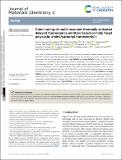Color tuning of multi-resonant thermally activated delayed fluorescence emitters based on fully fused polycyclic amine/carbonyl frameworks
Abstract
Two novel π-extended amine/carbonyl-based multi-resonance thermally activated delayed fluorescence (MR-TADF) emitters have been designed and synthesized. The two emitters are isomeric, composed of nine fused rings and show green-yellow emission. Sym-DiDiKTa and Asym-DiDiKTa possess tert-butyl groups distributed in a symmetrical and asymmetrical fashion, respectively, which significantly impact the single-crystal packing structure. The two compounds possess similar singlet–triplet energy gaps, ΔEST, of around 0.23 eV, narrowband emission characterized by a full-width at half-maximum, FWHM, of 29 nm and a photoluminescence quantum yield, ΦPL, of 70% and 53% for the symmetric and asymmetric counterparts, respectively, in toluene. Investigation in OLEDs demonstrated that the devices with Sym-DiDiKTa and Asym-DiDiKTa displayed electroluminescence maxima of 543 and 544 nm, and maximum external quantum efficiencies (EQEmax) of 9.8% and 10.5%, respectively. The maximum EQE was further improved to 19.9% by employing a hyperfluorescence strategy. We further present the first example of a neutral MR-TADF emitter incorporated in a LEC device where Sym-DiDiKTa acts as the emitter. The LEC shows a λEL at 551 nm and FWHM of 60 nm with luminance of 300 cd m−2 and a fast turn-on time of less than 2 s to 100 cd m−2.
Citation
dos Santos , J M , Chan , C-Y , Tang , S , Hall , D , Matulaitis , T , Cordes , D B , Slawin , A M Z , Tsuchiya , Y , Edman , L , Adachi , C , Olivier , Y & Zysman-Colman , E 2023 , ' Color tuning of multi-resonant thermally activated delayed fluorescence emitters based on fully fused polycyclic amine/carbonyl frameworks ' , Journal of Materials Chemistry C , vol. 11 , no. 24 , pp. 8263-8273 . https://doi.org/10.1039/d3tc00641g
Publication
Journal of Materials Chemistry C
Status
Peer reviewed
ISSN
2050-7526Type
Journal article
Description
Funding: The St Andrews team would like to thank EPSRC (EP/P010482/1) and the Leverhulme Trust (RPG-2016-047) for financial support. Computational resources have been provided by the Consortium des Équipements de Calcul Intensif (CÉCI), funded by the Fonds de la Recherche Scientifiques de Belgique (F. R. S.-FNRS) under Grant no. 2.5020.11. Y. O. acknowledges funding by the Fonds de la Recherche Scientifique-FNRS under Grant no. F.4534.21 (MIS-IMAGINE).Collections
Items in the St Andrews Research Repository are protected by copyright, with all rights reserved, unless otherwise indicated.

